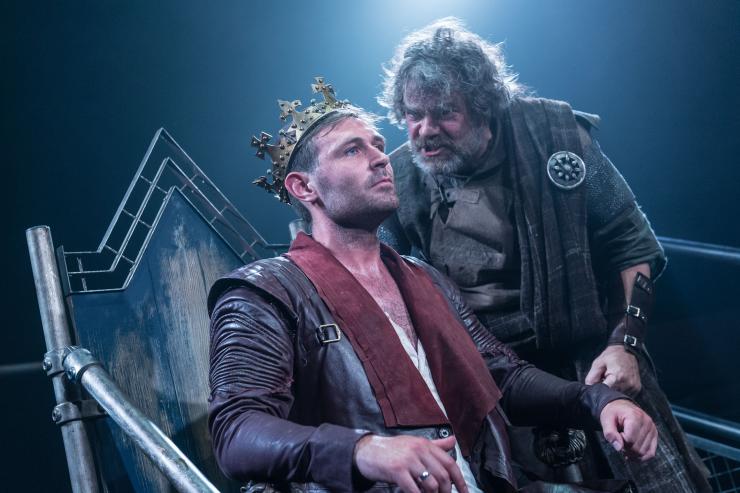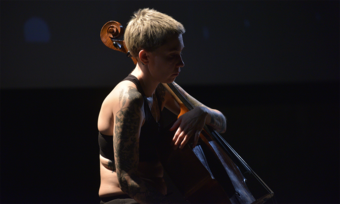The Scottish Independence Debate at the Edinburgh Festival, Part Two
Reimagining a National History
Ironically, the most stirring speeches about Scottish independence at this year’s Edinburgh Festival came from the first major collaboration between the National Theatre, based in London, and the National Theatre of Scotland. Produced at Edinburgh’s International Festival Theatre (before moving to London where it is currently playing), Rona Munro’s ambitious trilogy of history plays, James I, James II, and James III, was presented in a dynamic mixture of traditional and contemporary Scots dialect, filling out a virtually unknown history with surprising contemporary resonance. As my previous article discussed, it is rare to see a new play (let alone three plays) pitch so perfectly to the mood and questions of a present political moment.
Each of the plays chronicles the ascension to the throne of one of the Fifteenth Century monarchs, so we are introduced to each new King James at the moment in which they face the responsibility of ruling. The trilogy enables us to witness similar fears and rebellions played out by successive generations of Scots. It is a tribute to director Laurie Sansom that these very old stories feel fresh and young, brought alive by an energetic company of twenty actors who often seemed to bounce around the large stage, dwarfed by a two-story-high sword that had been thrust into the playing space, claiming its own long-standing ownership over the ground.
The trilogy enables us to witness similar fears and rebellions played out by successive generations of Scots.
Although she resists comparison to Shakespeare’s histories, Rona Munro readily admits that part of her motivation to write the trilogy was to offer Scotland access to a similarly epic (and yes, somewhat imagined) theatrical depiction of its history. In this way, her plays act as an open letter to her fellow Scots. In Monro’s own words, the plays “tell us about Scotland: that our history is a lot more complex than we think, and our present is made over a past that is a lot more present than we like to imagine.”

James I, subtitled The Key Will Keep the Lock, opens on a King who, having spent his entire adolescence locked up in an English prison, is released to a kingdom that had been ruled in his absence by the Stewart clan. One of the few historical documents that remain from the time is a love poem “The Kingis Quair” attributed to James I, that Munro uses as the basis for a rich love story between the King and his new queen Joan (played by Stephanie Hyam), who asks mostly for his protection rather than his love. Sansom directs James I (played by James McArdle) and his men in battle around the bed of a sleeping Joan, who seems at once protected and very close to the danger that will ultimately overwhelm her and her children.
James II, subtitled Day of the Innocents, opens with a compelling abstract dreamscape that takes us into the nightmares of James II (played by Andrew Rothney) as he repeatedly relives the childhood trauma of his father’s death and mother’s betrayal. The children in these sequences are played by life-sized puppets, and it is deliberately hard to locate the present moment as James shifts between memory and experience, conversing with people from the past and present simultaneously. Tormented by a childhood memory of being hidden in a box for his own protection, James is infantilized by the clan leaders, who refer to him as “Young James,” manipulate him, and subvert his rule. His French wife, Queen Mary, and his sister Annabella struggle to anchor him to a reality where he will have to turn against his closest friends in order to prove himself able to rule. As James gains control of his emotional landscape and of the country, the play gradually moves from the abstract and emotional towards a more linear narrative.
In the final play, James III, subtitled The True Mirror, Munro brings the cycle to a head by turning a mirror first on her characters and ultimately on her audiences. In another stylistic shift, James III (played by Jamie Sives) and his court are on stage as the audience arrives, dressed in semi-Twentieth Century attire and light-heartedly dancing to interpretations of pop songs (such as Pharrell Williams’s summer hit “Happy”) played by a Scottish folk band. Like the previous two plays, this one begins without any house announcements or curtain raising—a seamless passage from our world into that of the production. We are encouraged to clap along with the music and are seduced into the decadence of James III’s court without realizing it. Though loved by his family and court, this king is a vain playboy who arranges for a choir to follow him around and accompany his mood with music. He banishes his wife and first-born son who remind him that he is, in fact, aging. His neglect brings Scotland to the brink of Civil War.
But the real narrative of this play belongs to James III’s Danish wife, Queen Margaret, brilliantly performed by the Danish actress Sofie Gråbøl. She steals the show in a scene where her husband brings her a gift of a full-length mirror, hoping that she will be dismayed by her aging appearance. Instead, Margaret recognizes her own inner strength reflected, and proudly proclaims: “I like this woman!” This proves to be a transformative moment. Gråbøl herself points out that the queen is also a kind of mirror, and that as a foreigner, Margaret has a clarity of vision about Scotland that enables her to deliver “truths about the Scottish people that maybe you wouldn’t want to hear from one of your own.”
Having won the audience over with her strength and feminist body image, the sell out audiences at the Festival Theatre were electrified by Queen Margaret’s final speech rallying the people of Scotland to self-govern. After chastising her parliament (represented by both actors and audience-members seated on stage), Margaret turns out to the larger audience and recollects arriving in Scotland as a lonely, young girl, and how she gradually learned to understand and ultimately love Scotland—“You talked slowly till I understood. You showed me that the more frightened you are the better the joke you can tell about it.” The speech crescendos into:
Am I not the Queen of Scots?
Will you help me unite this country in peace?
Will you help me make Scotland’s law?
Will you let me do all I can in her name?
Gentlemen, will you help me rule?
Then tomorrow we can begin.
Together you and I will govern Scotland!
At this moment, the play transcended its story; the play was Scotland, and all of Scotland was the play. Audience members stood and cheered, applauded, and cried out. The climax of over seven hours of theater, this felt like the political rallying cry that the independence movement, as much as the “ungovernable” clan leaders on stage, had been waiting for.








Comments
The article is just the start of the conversation—we want to know what you think about this subject, too! HowlRound is a space for knowledge-sharing, and we welcome spirited, thoughtful, and on-topic dialogue. Find our full comments policy here